Abstract
The carcinogenicity of chromium compounds is reviewed with specific attention to the gaps in knowledge for risk estimation and research needs. The most important problems at present are whether trivalent chromium compounds cause cancer, and whether there is a difference in cancer causing effects between the soluble and the slightly soluble hexavalent compounds in the practical exposure situation. Dose estimates for risk estimation based on epidemiological investigations are also lacking.
Present evidence indicates that the trivalent chromium compounds do not cause cancer although high concentrations in some in vitro systems have shown genetic toxicity. Hexavalent chromium compounds cause cancer in humans, in experimental animals and exert genetic toxicity in bacteria and in mammalian cells in vitro. Epidemiological evidence and animal experiments indicate that the slightly soluble hexavalent salts are the most potent carcinogens, but proper identification and characterization of exposure patterns in epidemiological work are lacking. Workers also tend to have mixed exposures. Soluble and slightly soluble salts are equally potent genotoxic agents in vitro.
Further work for establishing dose estimates for risk evaluation in epidemiological work is important. In vitro systems should be applied for further identification of the mechanism of the carcinogenic effects, and animal experiments are urgent for comparison of the carcinogenic potency of the different hexavalent salts. Hexavalent chromium salts must be regarded as established carcinogens, and proper action should be taken in all industries with regard to such exposure. At present the carcinogenic risk to the general population caused by chromium compounds seems to be negligible, chromium in cigarettes, however, is an uncertainty in this respect. The amount of chromium and the type of chromium compounds inhaled from cigarettes is not known.
Full text
PDF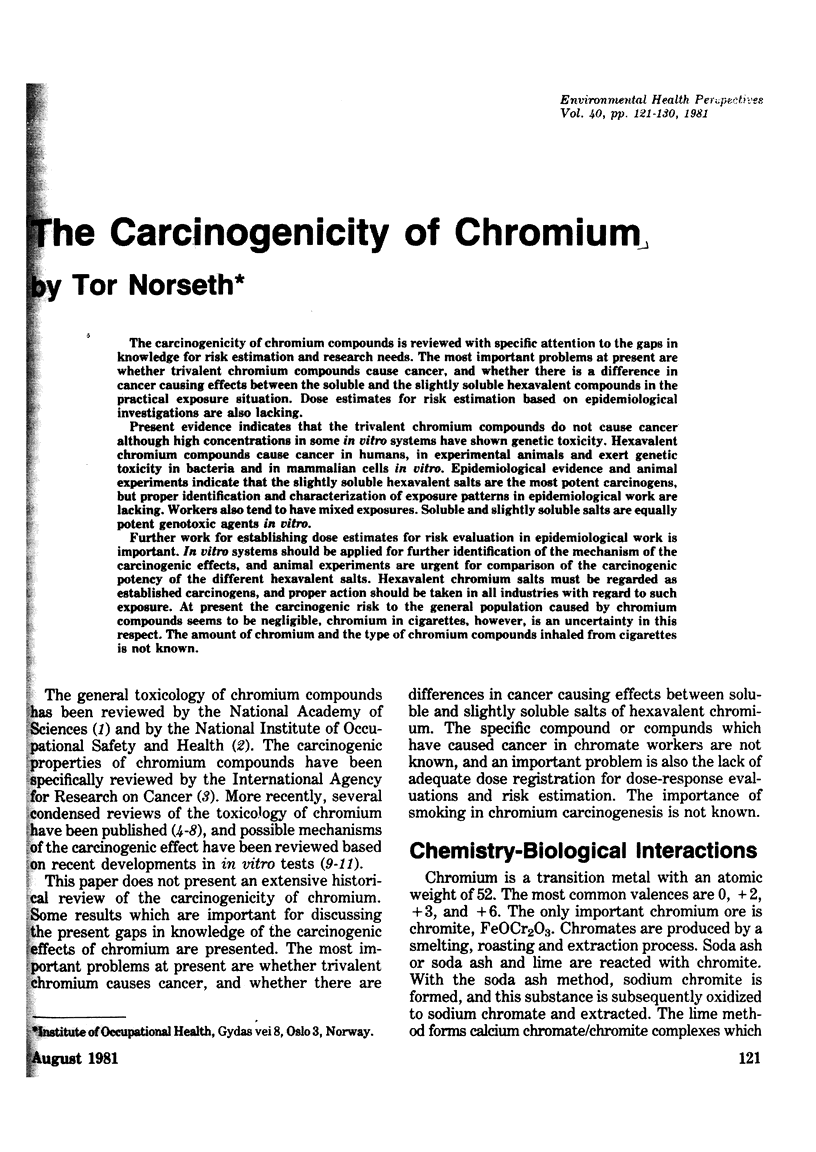

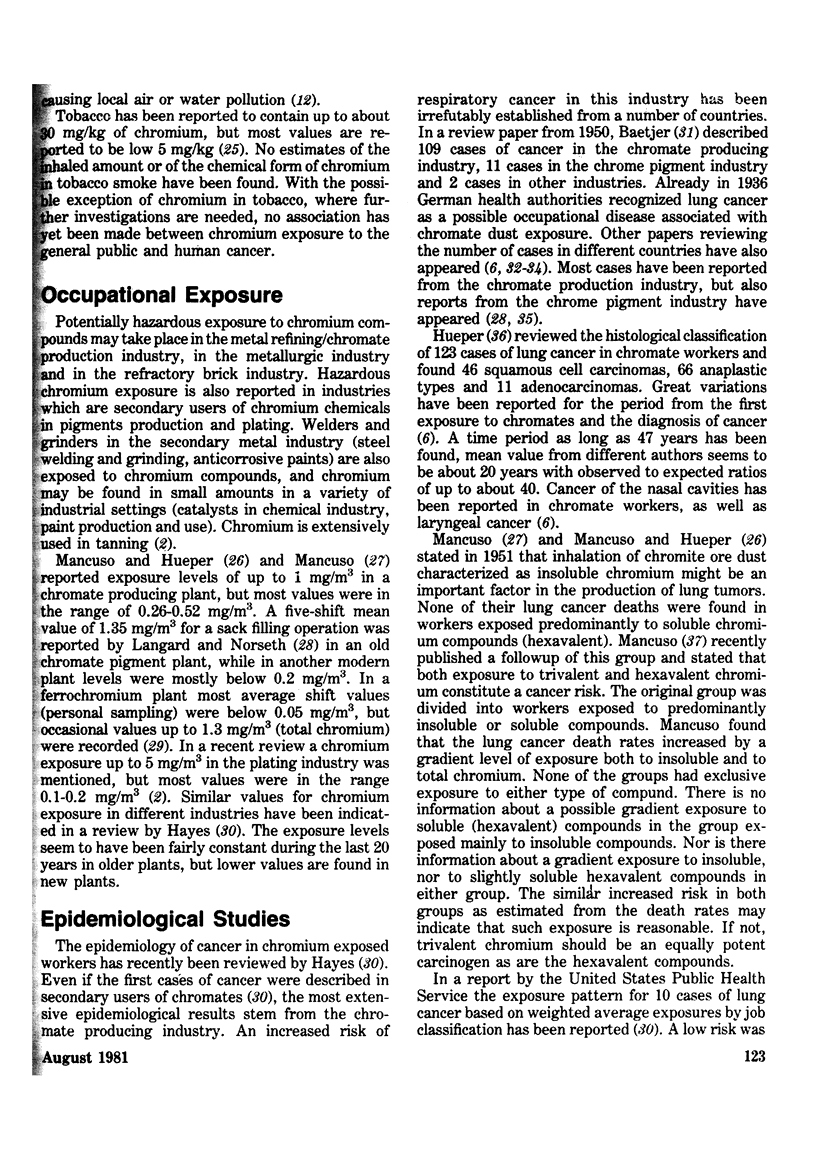
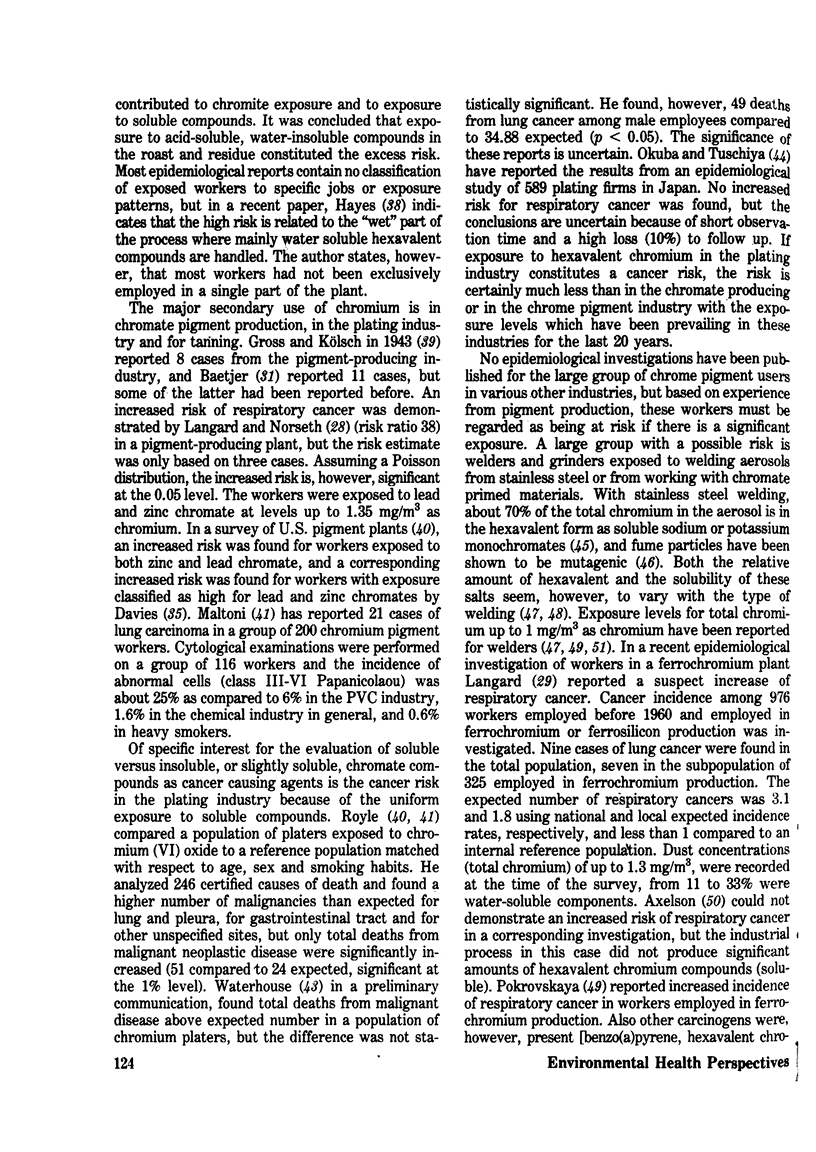
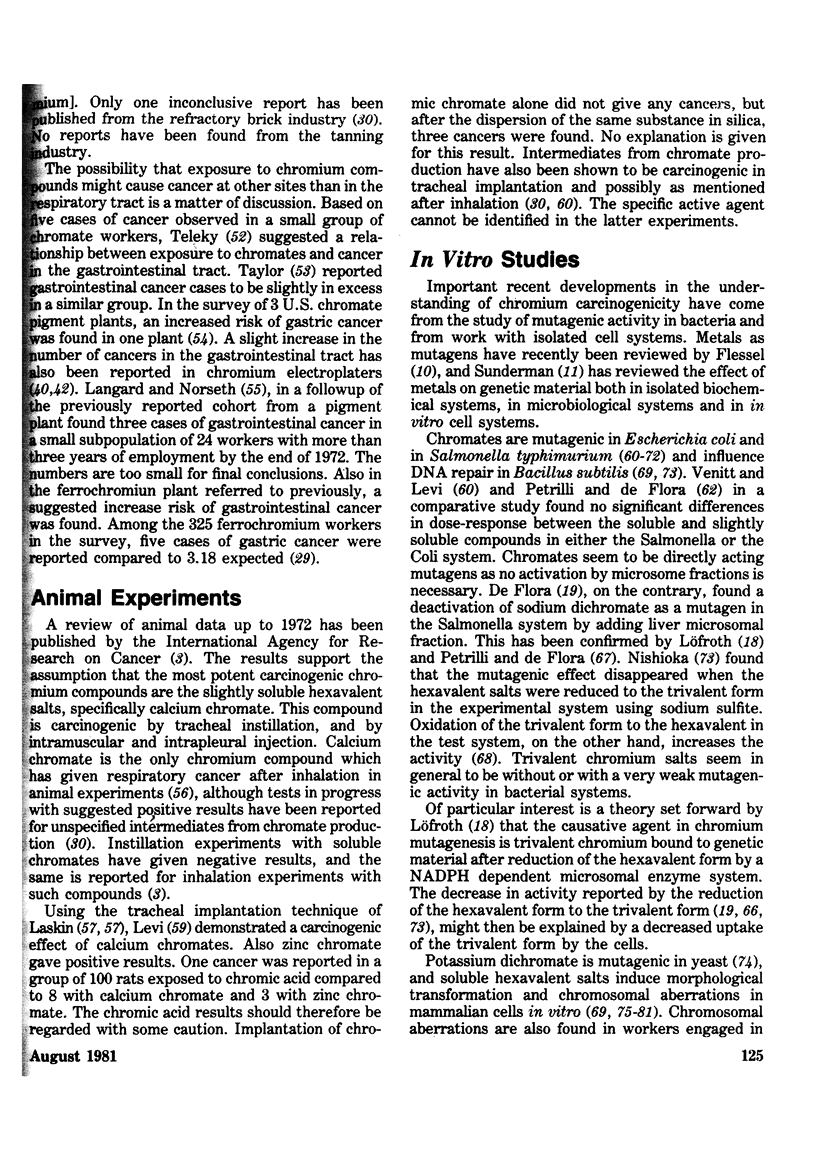
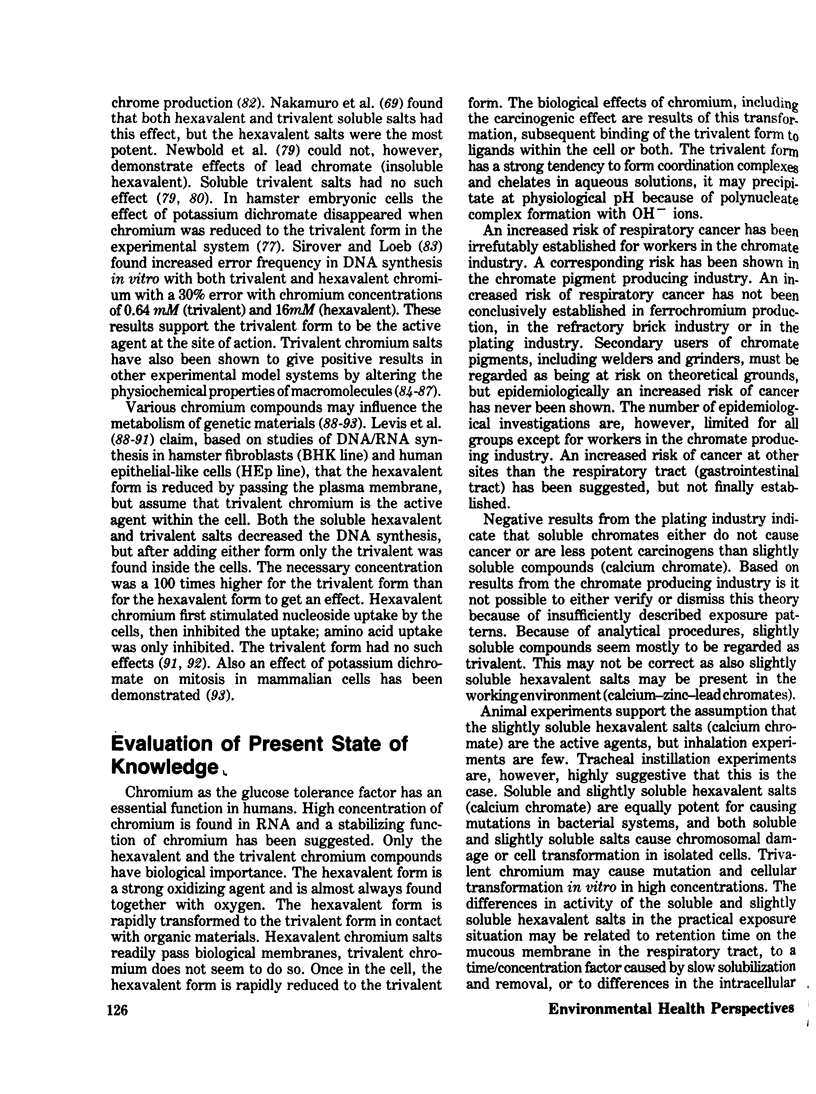
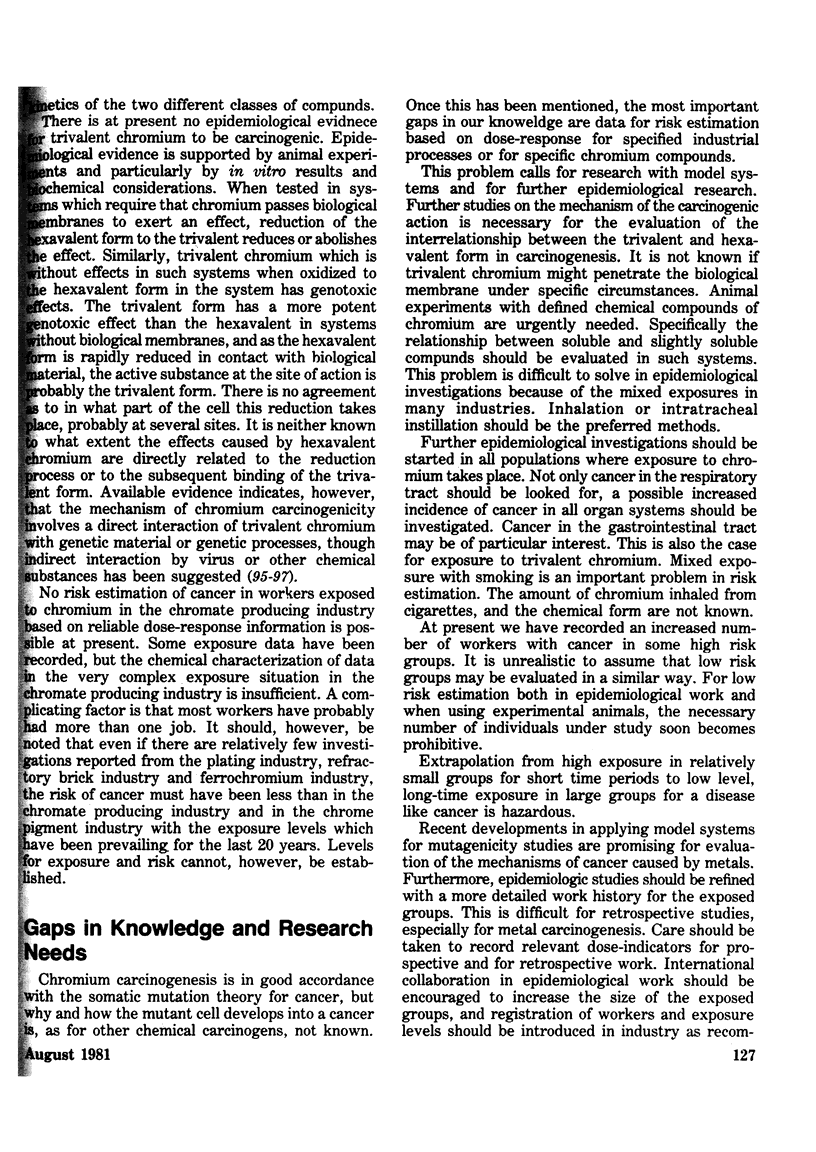
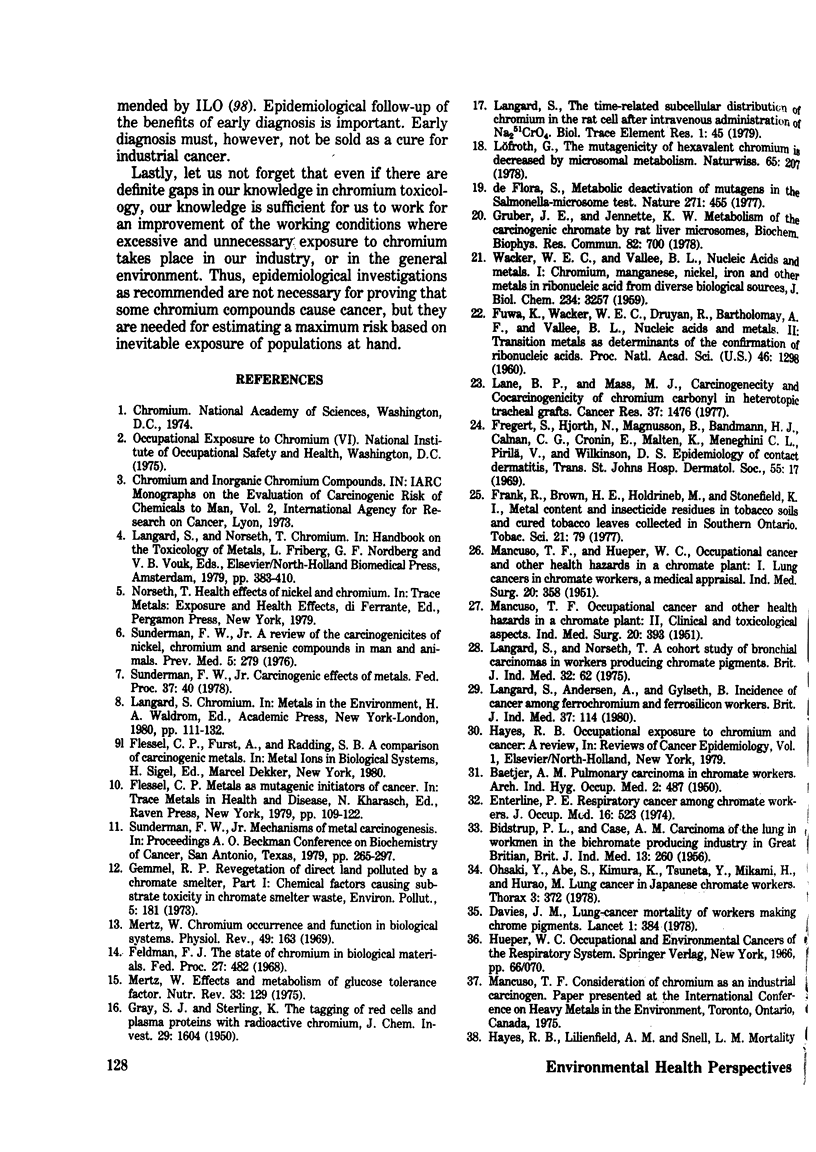


Selected References
These references are in PubMed. This may not be the complete list of references from this article.
- Axelsson G., Rylander R., Schmidt A. Mortality and incidence of tumours among ferrochromium workers. Br J Ind Med. 1980 May;37(2):121–127. doi: 10.1136/oem.37.2.121. [DOI] [PMC free article] [PubMed] [Google Scholar]
- BIDSTRUP P. L., CASE R. A. Carcinoma of the lung in workmen in the bichromates-producing industry in Great Britain. Br J Ind Med. 1956 Oct;13(4):260–264. doi: 10.1136/oem.13.4.260. [DOI] [PMC free article] [PubMed] [Google Scholar]
- Bianchi V., Levis A. G., Saggioro D. Differential cytotoxic activity of potassium dichromate on nucleoside uptake in BHK fibroblasts. Chem Biol Interact. 1979 Feb;24(2):137–151. doi: 10.1016/0009-2797(79)90003-6. [DOI] [PubMed] [Google Scholar]
- Bonatti S., Meini M., Abbondandolo A. Genetic effects of potassium dichromate in Schizosaccharomyces pombe. Mutat Res. 1976 Apr;38(2):147–150. [PubMed] [Google Scholar]
- Casto B. C., Meyers J., DiPaolo J. A. Enhancement of viral transformation for evaluation of the carcinogenic or mutagenic potential of inorganic metal salts. Cancer Res. 1979 Jan;39(1):193–198. [PubMed] [Google Scholar]
- Davies J. M. Lung-cancer mortality of workers making chrome pigments. Lancet. 1978 Feb 18;1(8060):384–384. doi: 10.1016/s0140-6736(78)91103-0. [DOI] [PubMed] [Google Scholar]
- De Flora S. Metabolic deactivation of mutagens in the Salmonella-microsome test. Nature. 1978 Feb 2;271(5644):455–456. doi: 10.1038/271455a0. [DOI] [PubMed] [Google Scholar]
- De Flora S. Metabolic deactivation of mutagens in the Salmonella-microsome test. Nature. 1978 Feb 2;271(5644):455–456. doi: 10.1038/271455a0. [DOI] [PubMed] [Google Scholar]
- DiPaolo J. A., Casto B. C. Quantitative studies of in vitro morphological transformation of Syrian hamster cells by inorganic metal salts. Cancer Res. 1979 Mar;39(3):1008–1013. [PubMed] [Google Scholar]
- Fuwa K., Wacker W. E., Druyan R., Bartholomay A. F., Vallee B. L. NUCLEIC ACIDS AND METALS, II: TRANSITION METALS AS DETERMINANTS OF THE CONFORMATION OF RIBONUCLEIC ACIDS. Proc Natl Acad Sci U S A. 1960 Oct;46(10):1298–1307. doi: 10.1073/pnas.46.10.1298. [DOI] [PMC free article] [PubMed] [Google Scholar]
- Green M. H., Muriel W. J., Bridges B. A. Use of a simplified fluctuation test to detect low levels of mutagens. Mutat Res. 1976 Feb;38(1):33–42. doi: 10.1016/0165-1161(76)90077-7. [DOI] [PubMed] [Google Scholar]
- Gruber J. E., Jennette K. W. Metabolism of the carcinogen chromate by rat liver microsomes. Biochem Biophys Res Commun. 1978 May 30;82(2):700–706. doi: 10.1016/0006-291x(78)90931-2. [DOI] [PubMed] [Google Scholar]
- HERRMANN H., SPECK L. B. Interaction of chromate with nucleic acids in tissues. Science. 1954 Feb 12;119(3085):221–221. doi: 10.1126/science.119.3085.221. [DOI] [PubMed] [Google Scholar]
- Hedenstedt A., Jenssen D., Lidestein B-M, Ramel C., Rannug U., Stern R. M. Mutagenicity of fume particles from stainless steel welding. Scand J Work Environ Health. 1977 Dec;3(4):203–211. doi: 10.5271/sjweh.2776. [DOI] [PubMed] [Google Scholar]
- Lane B. P., Mass M. J. Carcinogenicity and cocarcinogenicity of chromium carbonyl in heterotopic tracheal grafts. Cancer Res. 1977 May;37(5):1476–1479. [PubMed] [Google Scholar]
- Langård S., Andersen A. a., Gylseth B. Incidence of cancer among ferrochromium and ferrosilicon workers. Br J Ind Med. 1980 May;37(2):114–120. doi: 10.1136/oem.37.2.114. [DOI] [PMC free article] [PubMed] [Google Scholar]
- Lautner G. M., Carver J. C., Konzen R. B. Measurement of chromium VI and chromium III in stainless steel welding fumes with electrom spectroscopy for chemical analysis and neutron activation analysis. Am Ind Hyg Assoc J. 1978 Aug;39(8):651–660. doi: 10.1080/0002889778507830. [DOI] [PubMed] [Google Scholar]
- Levis A. G., Bianchi V., Tamino G., Pegoraro B. Cytotoxic effects of hexavalent and trivalent chromium on mammalian cells in vitro. Br J Cancer. 1978 Mar;37(3):386–396. doi: 10.1038/bjc.1978.58. [DOI] [PMC free article] [PubMed] [Google Scholar]
- Levis A. G., Buttignol M., Bianchi V., Sponza G. Effects of potassium dichromate on nucleic acid and protein syntheses and on precursor uptake in BHK fibroblasts. Cancer Res. 1978 Jan;38(1):110–116. [PubMed] [Google Scholar]
- Levis A. G., Buttignol M. Effects of potassium dichromate on DNA synthesis in hamster fibroblasts. Br J Cancer. 1977 Apr;35(4):496–499. doi: 10.1038/bjc.1977.75. [DOI] [PMC free article] [PubMed] [Google Scholar]
- Levis A. G., Buttignol M., Vettorato L. Inhibition of DNA synthesis in BHK fibroblasts treated in vitro with potassium dichromate. Experientia. 1977 Jan 15;33(1):82–84. doi: 10.1007/BF01936767. [DOI] [PubMed] [Google Scholar]
- MANCUSO R. F. Occupational cancer and other health hazards in a chromate plant: a medical appraisal. II. Clinical and toxicologic aspects. Ind Med Surg. 1951 Sep;20(9):393–407. [PubMed] [Google Scholar]
- MANCUSO T. F., HUEPER W. C. Occupational cancer and other health hazards in a chromate plant: a medical appraisal. I. Lung cancers in chromate workers. Ind Med Surg. 1951 Aug;20(8):358–363. [PubMed] [Google Scholar]
- Mertz W. Chromium occurrence and function in biological systems. Physiol Rev. 1969 Apr;49(2):163–239. doi: 10.1152/physrev.1969.49.2.163. [DOI] [PubMed] [Google Scholar]
- Mertz W. Effects and metabolism of glucose tolerance factor. Nutr Rev. 1975 May;33(5):129–135. doi: 10.1111/j.1753-4887.1975.tb07105.x. [DOI] [PubMed] [Google Scholar]
- Nakamuro K., Yoshikawa K., Sayato Y., Kurata H. Comparative studies of chromosomal aberration and mutagenicity of the trivalent and hexavalent chromium. Mutat Res. 1978 Nov;58(2-3):175–181. doi: 10.1016/0165-1218(78)90007-1. [DOI] [PubMed] [Google Scholar]
- Nestmann E. R., Matula T. I., Douglas G. R., Bora K. C., Kowbel D. J. Detection of the mutagenic activity of lead chromate using a battery of microbial tests. Mutat Res. 1979 Apr;66(4):357–365. doi: 10.1016/0165-1218(79)90046-6. [DOI] [PubMed] [Google Scholar]
- Nettesheim P., Hanna M. G., Jr, Doherty D. G., Newell R. F., Hellman A. Effect of calcium chromate dust, influenza virus, and 100 R whole-body x radiation on lung tumor incidence in mice. J Natl Cancer Inst. 1971 Nov;47(5):1129–1144. [PubMed] [Google Scholar]
- Newbold R. F., Amos J., Connell J. R. The cytotoxic, mutagenic and clastogenic effects of chromium-containing compounds on mammalian cells in culture. Mutat Res. 1979 May;67(1):55–63. doi: 10.1016/0165-1218(79)90099-5. [DOI] [PubMed] [Google Scholar]
- Nishioka H. Mutagenic activities of metal compounds in bacteria. Mutat Res. 1975 Jun;31(3):185–189. doi: 10.1016/0165-1161(75)90088-6. [DOI] [PubMed] [Google Scholar]
- Okubo T., Tsuchiya K. An epidemiological study on lung cancer among chromium plating workers. Keio J Med. 1977 Nov;26(3):171–177. doi: 10.2302/kjm.26.171. [DOI] [PubMed] [Google Scholar]
- Petrilli F. L., De Flora S. Metabolic deactivation of hexavalent chromium mutagenicity. Mutat Res. 1978 Oct;54(2):139–147. doi: 10.1016/0165-1161(78)90034-1. [DOI] [PubMed] [Google Scholar]
- Petrilli F. L., De Flora S. Toxicity and mutagenicity of hexavalent chromium on Salmonella typhimurium. Appl Environ Microbiol. 1977 Apr;33(4):805–809. doi: 10.1128/aem.33.4.805-809.1977. [DOI] [PMC free article] [PubMed] [Google Scholar]
- Petrilli F. L., de Flora S. Oxidation of inactive trivalent chromium to the mutagenic hexavalent form. Mutat Res. 1978 Nov;58(2-3):167–173. doi: 10.1016/0165-1218(78)90006-x. [DOI] [PubMed] [Google Scholar]
- Samitz M. H., Katz S. A., Scheiner D. M., Gross P. R. Chromium-protein interactions. Acta Derm Venereol. 1969;49(2):142–146. [PubMed] [Google Scholar]
- Schoental R. Chromium carcinogenesis, formation of epoxyaldehydes and tanning. Br J Cancer. 1975 Sep;32(3):403–404. doi: 10.1038/bjc.1975.241. [DOI] [PMC free article] [PubMed] [Google Scholar]
- Sirover M. A., Loeb L. A. Infidelity of DNA synthesis in vitro: screening for potential metal mutagens or carcinogens. Science. 1976 Dec 24;194(4272):1434–1436. doi: 10.1126/science.1006310. [DOI] [PubMed] [Google Scholar]
- Sunderman F. W., Jr Carcinogenic effects of metals. Fed Proc. 1978 Jan;37(1):40–46. [PubMed] [Google Scholar]
- Sunderman J. W., Jr A review of the carcinogenicities of nickel, chromium and arsenic compounds in man and animals. Prev Med. 1976 Jun;5(2):279–294. doi: 10.1016/0091-7435(76)90045-1. [DOI] [PubMed] [Google Scholar]
- Tsuda H., Kato K. Potassium dichromate-induced chromosome aberrations and its control with sodium sulfite in hamster embryonic cells in vitro. Gan. 1976 Jun;67(3):469–470. [PubMed] [Google Scholar]
- Umeda M., Nishimura M. Inducibility of chromosomal aberrations by metal compounds in cultured mammalian cells. Mutat Res. 1979 Jul;67(3):221–229. doi: 10.1016/0165-1218(79)90016-8. [DOI] [PubMed] [Google Scholar]
- Umeda M., Nishimura M. Inducibility of chromosomal aberrations by metal compounds in cultured mammalian cells. Mutat Res. 1979 Jul;67(3):221–229. doi: 10.1016/0165-1218(79)90016-8. [DOI] [PubMed] [Google Scholar]
- Venitt S., Levy L. S. Mutagenicity of chromates in bacteria and its relevance to chromate carcinogenesis. Nature. 1974 Aug 9;250(5466):493–495. doi: 10.1038/250493a0. [DOI] [PubMed] [Google Scholar]


